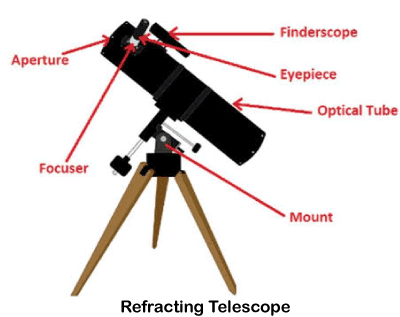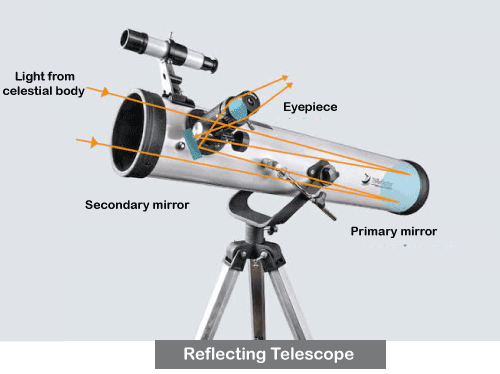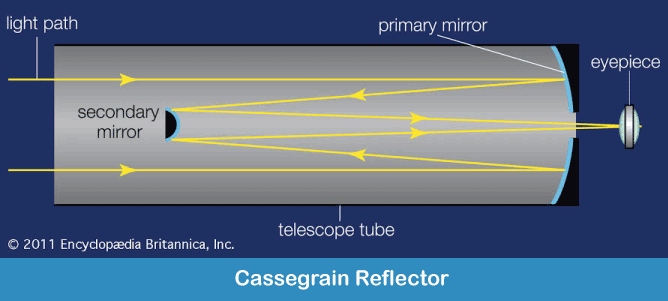Who invented telescopeAs there are many inventors who gave their contribution to the invention of an object, but the credit of the inventor always goes to that person who makes the object first with its practical use. The telescope was also developed by so many inventors, but the credit went to Hans Lippershey, a Dutch Glassmaker. 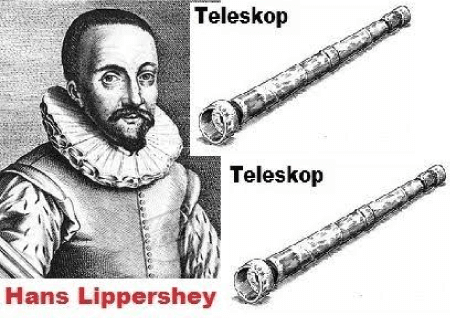
What is Telescope?It is a device used for seeing faraway objects. In a telescope, the lenses and curved mirrors are arranged in such a way that it could gather the lights and magnified the images so that far away objects look very nearer to us. Telescope made distant objects appear nearer, so basically, it is a tool for astronomers who used to see the faraway objects. The etymology of telescope has been taken from the Greek words 'tele', which meaning is 'far', and 'skopein', which meaning is 'to see', so the meaning of the word 'teleskopos' is 'far-seeing'. Developments of telescopeLet's discuss the essential developments of telescope. a. Early developmentThe Uses of lenses date back to ancient Greek when Ptolemy explained the properties of light. He illustrated the reflection, refraction, and the color of light. However, the proper use of lens started in the thirteen century in Italy after the manufacturing of spectacles by Hans Lippershey. In 1451 Nicholas of Cusa invented the use of concave lenses to correct near-sightedness. 1. Invention of Dutch telescopesIn 1608 Hans Lippershey, a Dutch eyeglass-maker, filed for the patent for his instrument with which faraway things look nearer and large. But only after few weeks Jacob Metius, a Dutch instrument maker, also filed for a patent. However, nobody awarded the patent, but Lippershey got a contract for copies of his design from the Dutch Government. In Dutch telescopes, concave and convex lenses were arranged in such a way that it was not able to magnify the images, because it has just 3x magnifications power. 2. Experiments on the telescope by several scientistsThe news of the invention of the telescope was spread across Europe as many scientists start their experiments, like Thomas Harriot, the English mathematician, and astronomer, who made a six-powered telescope to observe the features of the moon in 1609. b. Important development in a telescope1. Galileo GalileiGalileo Galilei of Venice made his own design and built a telescope. The telescope of Galileo was made up of a leaden tube in which both the lenses, the concave and the convex, were fixed at both ends of the tube. This kind of telescope is known as a Galilean telescope. Galileo's first telescope had a 3x magnification; after improvement, he made 8x, and finally, he made a meter long with a 37mm objective and a 23x magnification. The title telescope was first given by the Greek poet Giovanni Demisiani. And it was a Galileo's device which was called first with the title telescope. He demonstrated his instrument to the Venetian senate. After the presentation, he got the post of Lecturer at the University of Pauda. He discovered so many objects as he was the first who saw and observed the sky by using the telescope. He found out craters and mountains on the Moon, the Milky Way, Rings of Saturn, Sunspots and Jupiter's satellites, and the phases of Venus. He wrote the books "Dialogue Concerning the Two Chief World Systems and Ptolemaic and Copernican". Later due to the consideration of his ideas as heretical, he was sentenced to house arrest; however, he continued his work till death in 1642. 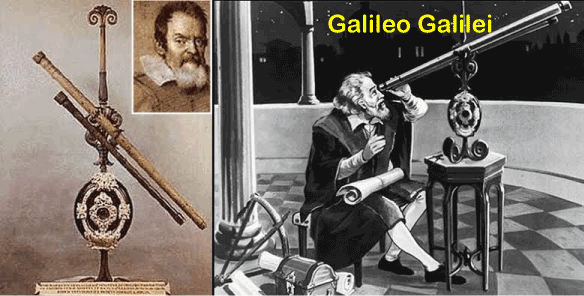
2. Keplerian telescopeFurther, with some modification, a new kind, refracting telescopes, experimented. It was Johannes Kepler who explained first the theory and developed a telescope made of a convex lens and a convex eyepiece lens (of two convex lenses) in 1611. The name of the telescope was catoptrics. After this telescope, many scientists were worked on the keplerian theory and made many improvements. Jesuit Christoph Scheiner was the first who built a telescope of this design, which description is mentioned in his Rosa Ursine (1630). William Gascoigne was the first who understand the importance of the keplerian telescope and said about its advantages. In this telescope, a small object could be fixed at the common focal point of the lenses. He invented the micrometer for the astronomical instrument. After him, Christian Huygens made some improvements in the Kepler telescope and built the first powerful telescope of its kind with compound eyepieces in 1655. The diameter of the telescope was 2.24 inches (57 mm), and the focal length was 12 ft (3.7m). With the help of this, he observed Saturn and find out its brightest satellites 'Titan' in 1655. He illustrated the ring of Saturn in his book "Systema Saturnium" in which he explained Saturn's ring. Further, due to the limitation in the sharpness of the images in Kepler's telescope, a new improvement as a very long focal length was created. Giovanni Cassini, with the telescope 35 feet (11 m) long, discovered 'Reha', the fifth satellite of Saturn, in 1672. 3. Aerial telescopeFurther, in 1675 a very long refracting telescope without a tube was made by the two brothers Christian and Constantijn Huygens. It was called aerial telescopes. The diameter of the telescope was 8.5 inches (220mm), and the focal length was 210 ft (64m). These aerial telescopes were mostly used for astronomy as Cassini, with the help of Giuseppe Campani's Aerial telescope (100 and 136 ft focal length) discovered the third and fourth satellite of Saturn in 1684. 4. Newtonian telescope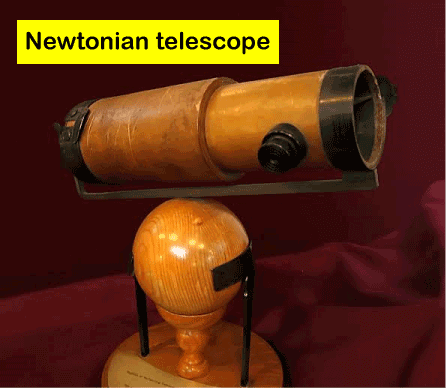
For creating images, the idea of a curved mirror was very old. Niccolo Zucchi, an astronomer from Italy, explained his experiment in his book Optica Philosophia which was published in 1652. He explained that in 1616 he experimented with the bronze concave mirror at the place of lenses in a refracting telescope. Further, some scientists experimented with mirrors in reflecting telescopes. But In this field, Isaac Newton was the first who built the first functional reflecting telescope in 1668, which later become dominant in astronomy. After doing extensive and much experiment, he used the concept of "Newtonian telescope". He placed a secondary diagonal mirror near the focal point of the primary mirror so that the image could be reflected at a 90o angle to the lenses fixed on the side of the telescope. The mirror diameter of his first telescope was 1.3 inches, and the focal ratio of f/5. With this experiment, he could see the Galilean satellite of Jupiter and the stages of Venus. He made another improvement and made a second telescope with 38x magnifying power and presented it to the royal society of London in 1672. This kind of telescope is named the Newtonian telescope. Further, in 1672 the third form of reflecting telescope was made by Laurent Cassegrain. It was made up of a convex hyperboloidal secondary mirror that reflects the light through a central hole of the main mirror. After this, it takes a long time to make new improvements in reflecting telescope. In 1721 John Hadley, inventor of octant, made a new improvement and built the first parabolic Newtonian reflector with a 6-inch diameter and 623/4 inch focal length. William Herschel did so many experiments and finally, in 1789, built his largest reflecting telescope with a mirror of 49 inches and a focal length of 40 ft. This design is called the Herschelian telescope. With this telescope, he discovered the sixth satellite of Saturn 'Enceladus' as well as the seventh 'Mimas'. However, for the next 50 years, this was the largest telescope in the world; it used less due to difficulty in the handle. In 1845 William parsons, the third earl of roses, developed a Newtonian reflector. This telescope was 72 inches long and known as the "leviathan of parson town". Through this telescope, he found out the spiral galaxies. However, with its advantageous design, there are also some defects in reflectors telescope as it has poor reflectivity and fast tarnishing nature in its mirror, due to which the mirror needs frequently removed and re-polished of itself. This process is time-consuming, and also it could change the curve of the mirror and need to be re-figured in order to correct the shape. 5. Achromatic refracting telescopeIn 1733 Chester Moore Hall succeeded in making the first achromatic refracting telescope with the achromatic lens. These lenses decreased the deficiency of objective lenses, which was unable to produce a clear image. In 1758 John Dollond tried this method and developed a telescope as well as made it commercial. With rapid improvement by 1866, several larger refracting telescopes were made. The aperture of these telescopes was 18 inches. In 1897 a Yerkes observatory telescope of 40-inch refractor was developed. This was the largest refracting telescope because, after this, the telescope larger than the refractor could not be developed due to the effect of gravity on the lens. 6. Cassegrain reflectorMoreover, in 1857 Leons Foucault built a telescope with silvering glass mirrors as well as the long-lasting aluminized coatings on reflectors mirrors in 1932. Further, a different variant, a Cassegrain reflector, was introduced by Ritchey-Chretien in 1910, but it was adopted widely only after 1950. Later, on the basis of this telescope, several telescopes were built. Hubble Space Telescope was one of them. 7. Active and adaptive optics in reflecting telescopeIn the 1980s, two new technology, active optics, and adaptive optics, were used in reflecting telescopes to improve image quality. These are computer-controlled telescopes. This method was developed by ESO new technology telescope. With the help of active optics, giant telescopes were built in the 1990s, like; Keck telescope 10 m (390 inches) in1993, the Gemini telescopes, the Very Large telescope, and the Large Binocular telescope. Furthermore, however, adaptive optics was first experimented by Horace W. Babcock in 1953, but that time it didn't use for common astronomical purposes. It came into use for common after computer technology in the 1990s. It was developed with several lasers as well as was working above kilohertz for better visible wavelengths. Wavelengths telescopesThe wavelength telescopes are categorized as: 1. Radio telescopes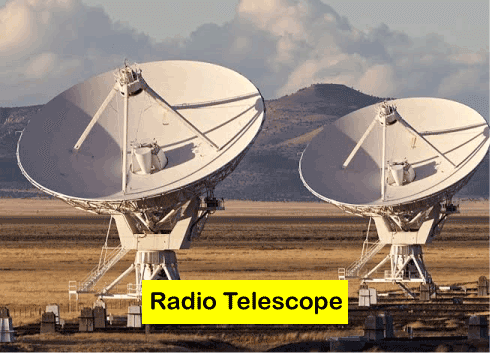
In the twentieth century, a new telescope was developed which uses wavelength to produce images. Several types of telescopes were developed for a wide range of wavelengths like; Radio, Gamma-rays, X-rays, and the longer infrared. In 1931 it was started with Karl Guthe Jansky, who found out that the radio waves come from the Milky Way. Further, Grote Reber, on the basis of Jansky's discovery, built a more sophisticated radio telescope in 1937 with a 31.4 foot (9.6m) dish. With the help of this, he discovered several radio sources in the sky. After the Second World War, various radio telescopes was built like; Jodrell bank 250-foot (76 m) in 1957, Green bank 300-foot (91m) in 1962, Effelsberg 100-m (330 ft) in 1971 and the largest Arecibo telescope 1000-foot (300m) in 1963. In 1964 cosmic microwave background radiation was discovered. The microwaves are high-energy radio waves. x2. Infrared telescopesFurther, the large millimeter telescope (850-4000m) observes from 0.85 to 4mm was a bridge between the far-infrared/submillimeter telescope and the longer wavelength radio telescope. Some important infrared telescopes are UKIRT 3.8-meter (150 inches), IRTF 3-meter (120 inches). Infrared astronomy was revolutionized after the launch of the IRAS satellite in 1983. The reflecting telescope with 60-cm (24-inch) mirror surveyed the entire sky for nine months. It detected 245,000 infrared sources. 3. Ultraviolet and X-ray astronomyUltraviolet radiation is absorbed by the ozone layer, so ultraviolet astronomy was conducted by satellites. The international Ultraviolet explorer surveyed the sky for 18 years with an aperture telescope 45-cm (18 inches). After this extreme- ultraviolet astronomy (10-100nm) was introduced. This astronomy had taken several methods of X-ray astronomy. Since X-rays can't reach on Earth's surface, it was held above the Earth's atmosphere. X-ray astronomy was started after the experiment on suborbital rocket flights. Through his experiment in 1948, the X-rays were detected in the sun as well as sources of X-rays in the galaxy were discovered in 1962. Uhuru was the first X-ray satellite that was developed in 1970. It found out so many as 300 sources of X-rays. After this, several X-ray satellites were built. The most recent of them are Chandra (1999) as well as Newton (1999). 4. Gamma rays astronomyAfter X-rays, Gamma rays astronomy was introduced. Since these rays are also absorbed in the atmosphere of the Earth, so this astronomy is also done by the satellites. In 1967 the astronomy on Gamma-rays was started after the launching of the OSO3 satellite. Later several Gamma-rays satellites were developed in which the Compton Gamma-ray observatory (1991) was the most powerful as it can detect the high-level energies of Gama-rays. Through Cerenkov radiation, very high-energy Gamma-rays can be detected from the ground. Some Cerenkov imagining telescopes were; HEGRA (1987), STACEE (2001), HESS (2003), and MAGIC 2004. The technique for measuring the diameter of a starFor measuring the diameter of stars, a Further Fourier transform was developed. This technique is called astronomical interferometry. First, this technique was used by Albert A. Michelson in 1891. He measured the diameters of Jupiter's satellite. In 1921 Michelson and Francis G. Peace could measure the diameter of a star with the help of their interferometer. In 1946 Ryle and Vonberg built a radio analog of Michelson interferometer. This telescope can scan the sky by using the movement of the Earth. In 1980 wide improvement were made in the aperture synthesis method for infrared astronomy, which made them to see the high-resolution images of the nearest stars. Further, this technique was applied to several other astronomical telescope arrays. In 2008 the Fast Fourier Transform telescope was presented by Max Tegmark and Matias Zaldarriaga. In this kind of telescope, all the lenses are dispensed during the transformation process. Types of telescopeBasically, there are three types of telescope.
Next TopicWho invented television
|
 For Videos Join Our Youtube Channel: Join Now
For Videos Join Our Youtube Channel: Join Now
Feedback
- Send your Feedback to [email protected]
Help Others, Please Share





